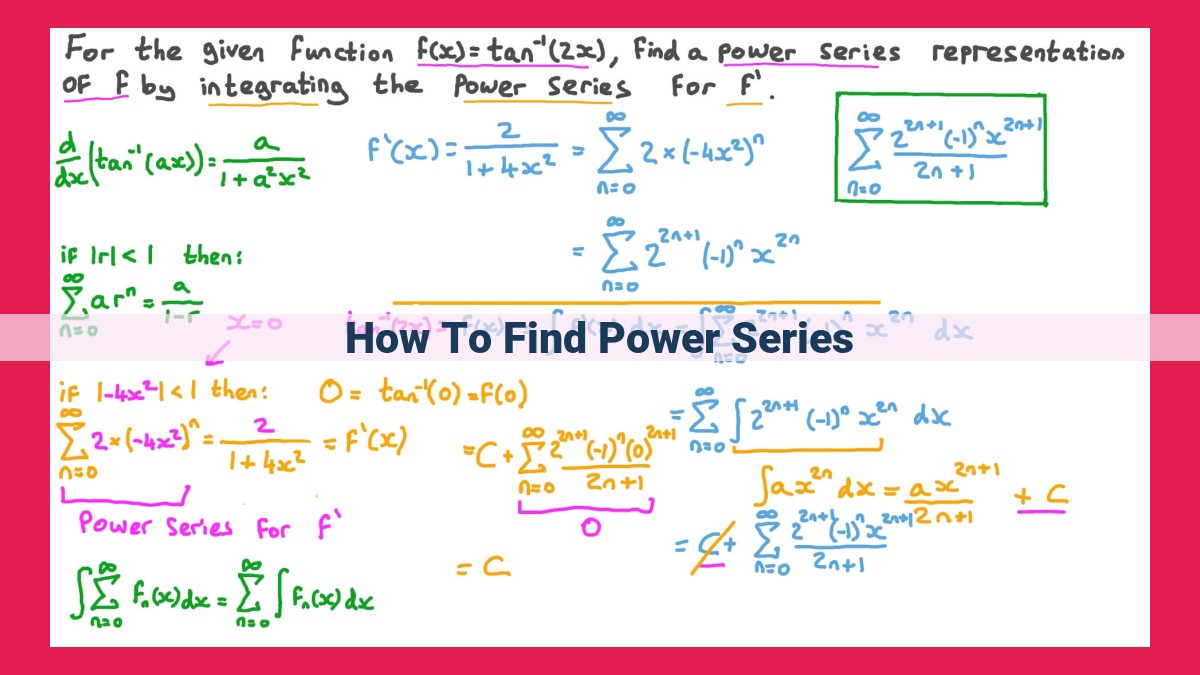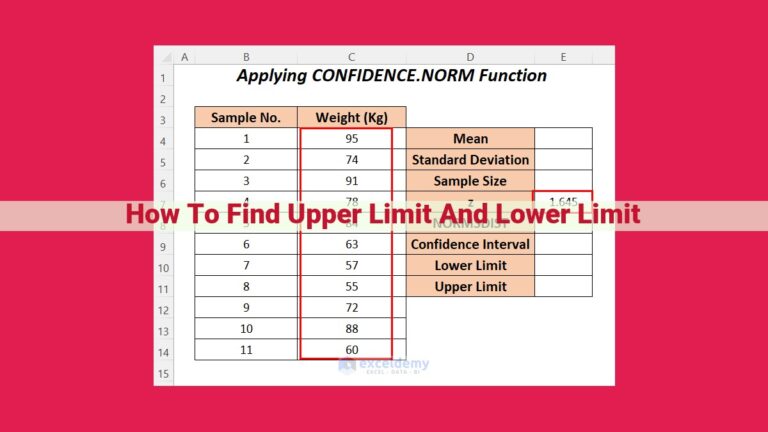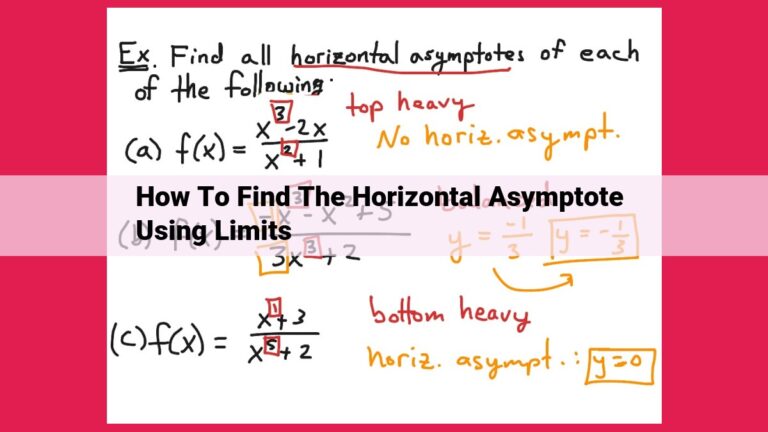Master Power Series: A Comprehensive Guide For Derivatives, Integrals, And Functions

To find power series, begin by understanding the concept and applications. Utilize derivatives to obtain Taylor and Maclaurin series, step-by-step for polynomials. Integrate using Cauchy’s formula for complex functions (e.g., exponential function). Explore geometric and binomial series, including convergence tests and examples (e.g., 1/(1-x)). Find power series for exponential and logarithmic functions via chain rule and logarithmic differentiation. Finally, use Taylor and Maclaurin series to obtain power series for trigonometric functions (e.g., sine, cosine, tangent).
Unveiling the Power of Power Series: A Journey into Mathematical Simplicity
In the realm of mathematics, power series emerge as a potent tool, offering a gateway to understanding complex functions. Let’s embark on a journey of discovery, unravelling the secrets behind these remarkable sequences.
A power series is a special type of infinite series expressed as:
f(x) = a_0 + a_1x + a_2x^2 + ... + a_nx^n + ...
where a subscripts are coefficients and x is an independent variable.
The beauty of power series lies in their ability to approximate functions. By summing up a finite number of terms, we obtain polynomial approximations that increasingly resemble the desired function as the number of terms grows. This approximation power makes power series invaluable in various fields, including physics, engineering, and finance.
Understanding power series is crucial for a deeper appreciation of mathematics. Their versatility and simplicity make them a cornerstone of mathematical analysis, enabling us to conquer complex functions with elegance and precision.
Finding Power Series Using Derivatives: Unraveling the Secrets of Function Approximations
In the realm of mathematics, power series play a pivotal role in representing functions as an infinite sum of terms. Finding power series using derivatives is a powerful technique that allows us to approximate functions with remarkable accuracy.
Taylor and Maclaurin Series: The Foundations
Two fundamental concepts in power series theory are Taylor and Maclaurin series. A Taylor series expands a function about a specific point, while a Maclaurin series is a special case where the expansion point is zero. These series provide a way to approximate functions by constructing polynomials that closely match the function’s behavior near the expansion point.
Step-by-Step Method: Demystifying the Process
To find a power series using derivatives, we follow a systematic approach:
- Find the derivatives of the function: Calculate the derivatives of the function at the expansion point.
- Evaluate derivatives at the expansion point: Substitute the expansion point into the derivatives to obtain their values.
- Form the power series: Write the power series as an infinite sum of terms, where each term consists of a coefficient multiplied by a power of (x – expansion point). The coefficients are determined by the evaluated derivatives.
Unveiling Examples: Polynomial Functions
Let’s consider an example involving a polynomial function. Suppose we want to find the power series for the function f(x) = x about the expansion point x = 1.
- Derivatives: f'(x) = 1, f”(x) = 0, f”'(x) = 0, …
- Evaluation: f(1) = 1, f'(1) = 1, f”(1) = 0, …
- Power series: x – (x – 1) + 0(x – 1)² + … = x
This power series converges to f(x) = x for all values of x.
Applications in Action
Power series found using derivatives have numerous applications, including:
- Approximating functions: By truncating the series, we can obtain a polynomial approximation of the function.
- Solving differential equations: Power series solutions can be used to find exact or approximate solutions to differential equations.
- Representing complex functions: Power series are a powerful tool for representing and analyzing complex functions.
Finding power series using derivatives provides a flexible and effective method for approximating functions. Whether for theoretical investigations or practical applications, understanding this technique empowers mathematicians and engineers to delve deeper into the world of function approximations.
Unveiling the Power of Integration: Finding Power Series
In the realm of mathematics, power series play a pivotal role in representing functions as an infinite sum of terms. While differentiation offers a powerful tool for finding power series, integration provides an alternative path to unraveling these mathematical mysteries.
Cauchy’s Integral Formula: A Window to Complex Functions
Cauchy’s integral formula stands as a cornerstone in the exploration of power series for complex functions. It elegantly expresses the coefficients of a power series as integrals involving the function and its derivatives.
Decoding Complex Functions with Power Series
By leveraging Cauchy’s integral formula, we can unlock the hidden power series representations of complex functions. This remarkable formula provides a systematic framework for expanding functions into an infinite sum of terms, granting us unprecedented insights into their behavior.
The Exponential Enigma: A Series of Exponentials
As an illuminating example, let’s delve into the power series for the enigmatic exponential function, ex. Using Cauchy’s integral formula, we discover an astonishing result: the power series for ex is simply an infinite sum of exponentials with coefficients determined by the function’s derivatives.
Unraveling the Power Series Tale: A Step-by-Step Guide
To harness the power of integration for finding power series, we embark on a step-by-step journey:
- Integrate the exponential function repeatedly: We repeatedly integrate ex to obtain its derivatives. Each successive derivative introduces an additional power of x.
- Evaluate the derivatives at x = 0: By setting x to zero, we evaluate the derivatives and obtain the coefficients for the power series.
- Construct the series: Using the computed coefficients, we assemble the power series representation of the exponential function ex.
This process reveals the remarkable structure of power series, showcasing an intimate connection between integration and the expansion of functions into an infinite sum of terms.
Integration emerges as a formidable tool in the discovery of power series, providing a means to unveil the hidden representations of complex functions. By harnessing Cauchy’s integral formula, we unlock the secrets of these infinite sums, gaining a deeper understanding of the mathematical landscape that shapes our world.
Geometric and Binomial Series: Unraveling the Power of Infinite Sums
In the realm of mathematics, power series emerge as powerful tools for representing functions as infinite sums. Among these series, geometric and binomial series hold a special place, unlocking a treasure trove of applications in various fields.
Geometric Series: A Sum with a Purpose
A geometric series is an infinite sum of terms that have a common ratio. Its general form is:
a + ar + ar^2 + ar^3 + ...
Where:
- a is the first term
- r is the common ratio
The convergence of a geometric series depends on the value of r. If |r| < 1, the series converges to a finite sum. However, if |r| ≥ 1, the series diverges.
Telescoping Series: A Geometric Series in Disguise
Telescoping series are a special type of geometric series where consecutive terms cancel out, leaving only the first and last terms. For example, the following series is a telescoping series:
1 - 1/2 + 1/4 - 1/8 + ...
Each term is the negative of the next, so the sum collapses to:
1 - 1/2 = 1/2
Unifying Power and Binomial: The Binomial Theorem
The binomial theorem establishes a remarkable connection between power series and binomial expansions. It states that for any real number n:
(1 + x)^n = 1 + nx + n(n-1)/2 * x^2 + ...
This formula allows us to express a polynomial as an infinite sum of terms, each with a binomial coefficient. The convergence of a binomial series depends on the values of x and n.
Power Series for 1/(1-x)
One notable application of geometric series is finding the power series for 1/(1-x). This series, known as the geometric progression, converges for |x| < 1:
1/(1-x) = 1 + x + x^2 + x^3 + ...
Convergence Tests for Binomial Series
Testing the convergence of binomial series is crucial to ensure their validity. Two common tests are:
- Ratio Test: If |a_{n+1}/a_n| → L as n → ∞, where a_n is the n-th term, then the series converges if L < 1 and diverges if L > 1.
- Comparison Test: If 0 ≤ a_n ≤ b_n for all n and the series ∑b_n converges, then the series ∑a_n also converges.
Power Series for Exponential and Logarithmic Functions
In the world of mathematics, power series play a pivotal role in representing functions as infinite sums of terms. They provide a powerful tool for exploring the behavior of functions, particularly when they exhibit complex or non-elementary characteristics.
Using the Chain Rule for Exponential Functions
Exponential functions are defined by raising a constant base to a variable exponent. To find their power series, we employ the chain rule. The chain rule breaks down a complex function into simpler components, allowing us to differentiate it term by term. By repeatedly applying the chain rule, we can derive the power series for any exponential function.
Using Logarithmic Differentiation for Logarithmic Functions
Logarithmic functions, on the other hand, are the inverse of exponential functions. They are defined by taking the logarithm of a variable base. To find their power series, we use logarithmic differentiation. This technique involves taking the derivative of the logarithm of the function, which transforms it into a polynomial-like form. By expanding the logarithm using its power series, we can derive the power series for the logarithmic function.
Example: Power Series for e^x
One of the most important exponential functions is e^x. Its power series can be derived using the chain rule:
f(x) = e^x = 1 + x + (x^2)/2! + (x^3)/3! + ...
This series converges for all values of x, making it a valuable tool for approximating the exponential function.
Power series provide a powerful tool for understanding the behavior of exponential and logarithmic functions. By utilizing the chain rule and logarithmic differentiation, we can derive their power series and gain insights into their properties and applications. These series are essential for exploring the world of higher-order functions and solving complex mathematical problems.
Exploring the Power of Trig: Unlocking the Mysteries of Trigonometric Power Series
In the realm of mathematics, power series offer a remarkable tool for unlocking the intricacies of complex functions, providing a powerful means to express them as infinite sums of simpler terms. When it comes to trigonometric functions, these series hold a special significance, paving the way for a deeper understanding of these fundamental building blocks.
Taylor and Maclaurin’s Triumph: Capturing Trig Functions in Power Series
At the heart of power series for trigonometric functions lies the elegant Taylor series expansion, named after the brilliant English mathematician, Brook Taylor. This formula allows us to represent any differentiable function as an infinite sum of its derivatives evaluated at a specific point. For trigonometric functions, the point of interest is often zero, leading to what’s known as the Maclaurin series.
Half-Angle Magic: Bridging the Gap of Trigonometric Identities
As we delve deeper into the world of trigonometric power series, the concept of half-angle formulas emerges as a valuable tool. These identities provide a clever way to express trigonometric functions of half angles in terms of their original counterparts. By harnessing the power of these formulas, we can extend our power series expansions to encompass a wider range of trigonometric functions.
Golden Examples: Unveiling the Power Series for Sine, Cosine, and Tangent
To illustrate the practical significance of trigonometric power series, let’s consider the emblematic examples of sine, cosine, and tangent functions. Their respective power series provide invaluable approximations for these functions, making them indispensable in a vast array of applications, from physics to engineering. By understanding their power series representations, we gain a deeper appreciation for the intricate tapestry of trigonometric functions.
Harnessing the Transformative Power of Power Series
The exploration of trigonometric power series not only enriches our mathematical understanding but also unveils a treasure trove of practical implications. These series empower us to approximate trigonometric functions with remarkable accuracy, enabling us to solve complex equations, analyze periodic phenomena, and unlock the secrets of waves and oscillations. Their versatility makes them an indispensable tool, extending their reach far beyond the confines of mathematical theory.


